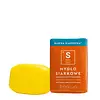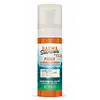What's inside
What's inside
 Key Ingredients
Key Ingredients

No key ingredients
 Benefits
Benefits

 Concerns
Concerns

 Ingredients Side-by-side
Ingredients Side-by-side

Water
Skin ConditioningPropylene Glycol
HumectantCoco-Glucoside
CleansingTrehalose
HumectantPEG-7 Glyceryl Cocoate
EmulsifyingCocamidopropyl Betaine
CleansingAloe Barbadensis Leaf Juice
Skin ConditioningGlycerin
HumectantNordihydroguaiaretic Acid
AntioxidantOleanolic Acid
Skin ConditioningMel Extract
MoisturisingPanthenol
Skin ConditioningSulfur
AntiseborrhoeicLinoleic Acid
CleansingLinolenic Acid
CleansingTocopheryl Acetate
AntioxidantRetinyl Palmitate
Skin ConditioningBioflavonoids
Skin ConditioningBiotin
AntiseborrhoeicPyridoxine Hcl
Skin ConditioningAllantoin
Skin ConditioningCocamidopropylamine Oxide
CleansingPEG-60 Almond Glycerides
EmulsifyingPolysorbate 20
EmulsifyingPolyglyceryl-4 Laurate/Sebacate
SolventPolyglyceryl-6 Caprylate/Caprate
StabilisingCaprylyl Glycol
EmollientEthylhexylglycerin
Skin ConditioningPEG-40 Hydrogenated Castor Oil
EmulsifyingCarbomer
Emulsion StabilisingPEG-30 Castor Oil
EmulsifyingButylene Glycol
HumectantParfum
MaskingCitric Acid
BufferingPhenoxyethanol
PreservativeWater, Propylene Glycol, Coco-Glucoside, Trehalose, PEG-7 Glyceryl Cocoate, Cocamidopropyl Betaine, Aloe Barbadensis Leaf Juice, Glycerin, Nordihydroguaiaretic Acid, Oleanolic Acid, Mel Extract, Panthenol, Sulfur, Linoleic Acid, Linolenic Acid, Tocopheryl Acetate, Retinyl Palmitate, Bioflavonoids, Biotin, Pyridoxine Hcl, Allantoin, Cocamidopropylamine Oxide, PEG-60 Almond Glycerides, Polysorbate 20, Polyglyceryl-4 Laurate/Sebacate, Polyglyceryl-6 Caprylate/Caprate, Caprylyl Glycol, Ethylhexylglycerin, PEG-40 Hydrogenated Castor Oil, Carbomer, PEG-30 Castor Oil, Butylene Glycol, Parfum, Citric Acid, Phenoxyethanol
 Reviews
Reviews

Ingredients Explained
These ingredients are found in both products.
Ingredients higher up in an ingredient list are typically present in a larger amount.
Glycerin is already naturally found in your skin. It helps moisturize and protect your skin.
A study from 2016 found glycerin to be more effective as a humectant than AHAs and hyaluronic acid.
As a humectant, it helps the skin stay hydrated by pulling moisture to your skin. The low molecular weight of glycerin allows it to pull moisture into the deeper layers of your skin.
Hydrated skin improves your skin barrier; Your skin barrier helps protect against irritants and bacteria.
Glycerin has also been found to have antimicrobial and antiviral properties. Due to these properties, glycerin is often used in wound and burn treatments.
In cosmetics, glycerin is usually derived from plants such as soybean or palm. However, it can also be sourced from animals, such as tallow or animal fat.
This ingredient is organic, colorless, odorless, and non-toxic.
Glycerin is the name for this ingredient in American English. British English uses Glycerol/Glycerine.
Learn more about GlycerinPropylene Glycol is an odorless, colorless liquid. As a humectant, it helps skin retain moisture. It also aids in delivering active ingredients.
Another role of this ingredient is preventing a product from melting or freezing. Propylene glycol also adds antimicrobrial properties to a product, elongating product lifespan.
This ingredient is considered an organic alcohol and commonly added into both cosmetics and foods.
Those with sensitive skin or conditions may develop a rash when using this ingredient.
Learn more about Propylene GlycolSulfur is a commonly occurring element on Earth (and our universe!). In cosmetics, it helps kill bacteria, reduces sebum, and provides exfoliation. This makes it an effective ingredient to reduce breakouts and fight acne.
As a ketayolytic agent, it breaks down the top layer of skin. This is a form of exfoliation and may help decrease acne and hyperpigmentation.
Studies show sulfur has antibacterial and antifungal properties. Sulfur can be drying if used excessively or at higher concentrations. We recommend speaking with a medical professional if you have any concerns.
Ancient Greece, India, China, and Egypt have used sulfur in both traditional medicines and for household use.
Learn more about SulfurWater. It's the most common cosmetic ingredient of all. You'll usually see it at the top of ingredient lists, meaning that it makes up the largest part of the product.
So why is it so popular? Water most often acts as a solvent - this means that it helps dissolve other ingredients into the formulation.
You'll also recognize water as that liquid we all need to stay alive. If you see this, drink a glass of water. Stay hydrated!
Learn more about Water